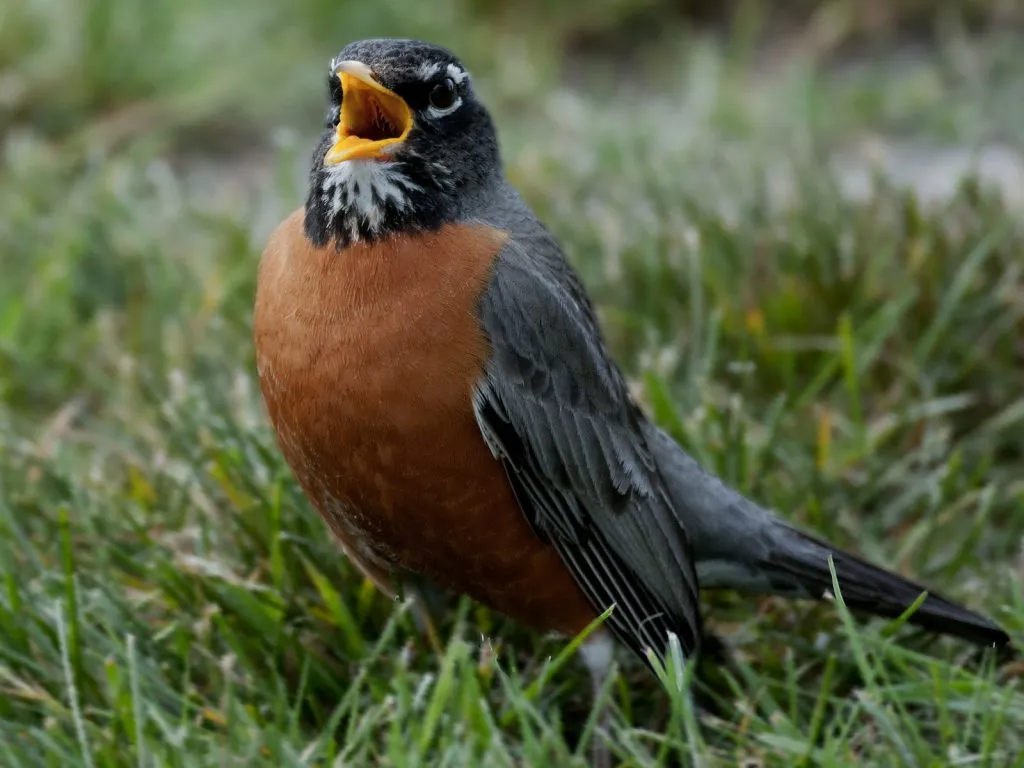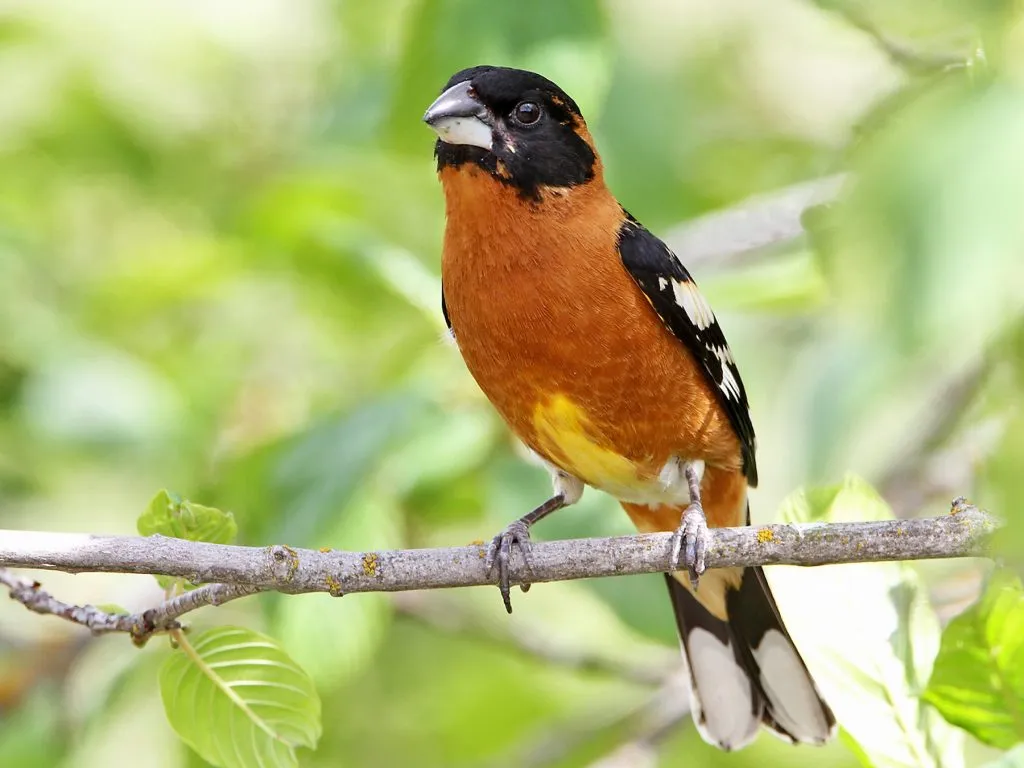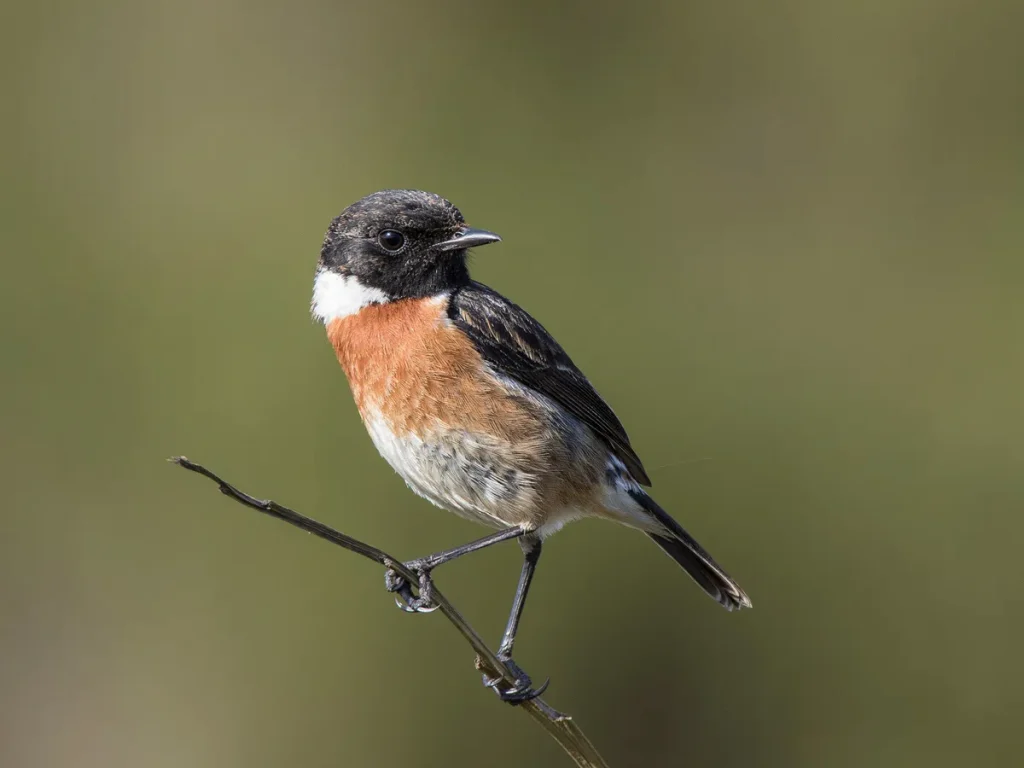Last Updated on: February 5, 2025
From the woods to the backyards, you will find lots of birds with orange chests. They are beautiful and head-turning, making them a popular target for birdwatching and photography.
Also…
Many of the orange-bellied birds are from the Passeriformes family, which is a group of songbirds. However, they can be confusing to identify, especially for someone who does not have extensive birding knowledge.
If you need help identifying a bird with an orange chest, read on. We’ll talk about some of the most common species, including their characteristics and behaviors.
The Most Common Orange-Chested Birds
1. American Robin

A member of the thrush family, the American robin is a songbird. The lovely orange breast and belly complement its white rump and undersides, and gray tail, back, and wings.
The American robin has a varied diet, which changes depending on the season. In the summer, it consumes invertebrates. Meanwhile, in the spring, it eats worms and insects. On the other hand, it consumes hanging fruits in the fall and winter.
You will find American robins almost everywhere in North America, even in the coldest regions like Alaska. There can be differences in plumage depending on the region they inhabit.
The most common habitats are suburban backyards, parks, grasslands, and woodlands.
Fun Fact: American robins have approximately 2,900 feathers.
2. Eastern Bluebird

The first thing that you will notice in this bird is its beautiful deep blue back and wings. The rump and belly are snowy white. The belly has an orange flank, which turns darker as it approaches the breast.
Eastern bluebirds love eating beetles, crickets, and caterpillars. As winter approaches, their diet will also include berries and fruits.
During courtship, male eastern bluebirds will sing and flutter to impress females. Males can also feed females. The breeding season of these birds is from March to July.
Throughout the year, you will find these birds in the Eastern United States.
3. Western Bluebird

Eastern and western bluebirds have an almost similar appearance. One of the main differences is that males have a rusty brown patch on their back and a blue throat. The lower belly is also gray and not white. Meanwhile, females are mostly gray.
During summer, western bluebirds eat mainly insects. In the winter, they will eat juniper berries. You can also attract them to bird feeders in the warmer months by providing mealworms.
Most of the time, western bluebirds live in farms, open conifer forests, and locations with scattered trees. Meanwhile, their breeding grounds include semi-open areas with oak and pine.
4. Rufous Hummingbird

With their bright-orange bodies, rufous hummingbirds are easily recognizable even from afar. The white patch below their throats creates a beautiful contrast.
Male rufous hummingbirds have an iridescent red throat. Meanwhile, females are greenish-brown on the back, whitish on the belly, and rusty on the sides.
With their size, the rufous hummingbirds are amongst the longest-traveling birds. During migration, they can travel up to 4,000 miles each time.
Since the 1970s, the population of rufous hummingbirds are steadily declining. Pesticide exposure and climate change are some culprits for their limited distribution.
5. Black-headed Grosbeak

As the name implies, the most prominent physical characteristic of the black-headed grosbeak is its black head. Adult males are easily recognizable with their cinnamon bodies and white bars in their black wings.
When foraging, this orange-breasted bird spends most of its time in trees and shrubs looking for food in dense foliage. The diet is mostly seeds, berries, and insects, including beetles, wasps, and caterpillars.
You will find black-headed grosbeaks in suburban areas, deserts, and mountains in Western North America.
6. Red-Breasted Nuthatch

While they are called red-breasted nuthatches, they fit the category of orange-breasted birds since you can find many of them with pale colors. They also have black and white stripes on their heads.
The red-breasted nuthatch has the reputation for being a weak excavator. They prefer old and decaying cavities instead of those from healthy trees.
If you want to see a red-breasted nuthatch in the wild, check out coniferous mountains and woods. Look for areas with western red cedar, larch, hemlock, fir, pine, and spruce.
As for the diet, a red-breasted nuthatch will eat both seeds and insects. Its favorites include spiders in the summer. Come winter, they love seeds from conifers.
7. Baltimore Oriole

The bodies of adult males are bright orange with white wing bars on their black wings. They have an orange chest and belly, which you will not find in females.
Baltimore orioles are known for creating beautiful nests. Females will gather and weave hair, string, and grass to produce hanging nests, which can be suspended at a height of up to 30 feet. The nest of a Baltimore oriole is durable and can still be used once birds come back after migration.
You can find Baltimore orioles in North, South, and Central America. These birds forage on wasps, mealworms, flowers, and fruits. It is possible to attract Baltimore orioles in backyards through bird feeders with drinking ports and perches. Make sure to provide oranges and jellies for these orange-breasted birds!
8. Barn Swallow

The barn swallow is almost the same size as a sparrow. On average, the length is 5.9 to 7.5 inches. Meanwhile, the wings span 11.4 to 12.6 inches.
One of the best ways to identify barn swallows is through their steel-blue backs. They have blue crowns and cinnamon throats and foreheads.
A barn swallow will use its wings to catch food above the ground or water at a height of up to 100 feet. When flying, it can execute tight turns and quick dives.
Barn swallows are known for having adaptable habitats. They can live in roadway edges, parks, bridges, barns, meadows, marshes, and ponds.
9. Bullock’s Oriole

With their bright orange chests and bellies and black and white wings, it is easy to identify Bullock’s oriole. Immatures and females are duller compared to males.
Most of the sightings of Bullock’s orioles are in the northern parts of North America. They frequent the pacific regions and Rocky Mountain. In the winter, they will migrate, and you will see many of them in the lower portion of California.
Like the Baltimore oriole, Bullock’s oriole is known for being a weaver. It makes nests from fibrous materials that are strong enough to withstand strong winds and heavy rains.
This brown-headed cowbird is a keen observer. They are also vocal.
10. Allen’s Hummingbird

Male Allen’s hummingbirds have bronze backs that transform into orange approaching the rump. They have short orange tails and small gray wings. The bib is a vibrant orange. They have straight long black bills. Females, on the other hand, are coppery-green on the back.
This orange-breasted bird is small, making it quite a challenge to spot. On average, the length is only 3.5 inches.
If you want to see Allen’s hummingbirds in their natural habitats, make sure to check out brushy canyons, open oak woods, well-wooded suburbs, and city parks.
During the breeding season, you will find Allen’s hummingbirds only in California. There are a few migrants in the winter, which will come to Mexico.
11. Orange-Breasted Falcon

A widespread but rare bird, the orange-breasted falcon only occupies about 4% of its historical range in Central and South America, specifically in Guatemala and Belize.
It is often confused with bat falcons. However, the most common difference is that the latter has a wider distribution.
With a near-threatened status, it is almost impossible to see an orange-breasted falcon.
12. American Woodcock

A plump shorebird with short legs, the length of the American woodcock ranges from 9.8 to 12.2 inches. When it is flying, the wings can extend up to 18.9 inches.
American woodcocks are common in Eastern North America, especially in forests with open areas. They can also live on farms as they often move from one habitat to another.
Most of the time, they are solitary birds. They are active from dawn to dusk. There are also instances when they are active during moonlit nights.
To communicate, they will use their songs and physical displays. Their songs often include four calls. Males perform a sky dance to attract a partner.
13. Red Knot

A small and brownish bird, the red knot can fly up to 9,000 miles in the spring from north to south. In the autumn, it will conduct the same trip. As such, it is a long-distance migrant bird.
These orange birds are from the family of sandpipers. They have brilliant orange underparts.
The diet of red knots is mainly horseshoe crab eggs, making them a common sight on beaches or coastal areas. It can also eat insects, green vegetation, seeds, and mollusks.
It is a common sight in tidal flats where it will forage by probing its bills in the mud. Meanwhile, on dry grounds, it will pick items on the surface.
As for their geographic distribution, you can find them in North America and almost all other continents, including Australia, South America, and Africa.
14. Varied Thrush

Males are blue-gray on the top, orange below, and have black auricular. Females are almost similar, but their upper part is mostly brown.
In North America, at least four varieties are present with varying colors. Some are paler while others are darker. Their range is limited in the Pacific Northwest.
Aside from their colors, you can also identify these birds through their haunting calls, especially males. They have whistled tones, which you can hear mostly in the morning and evening.
As it is common with other birds in the thrush family, they like eating protein-rich insects. In the winter, their diet switches to acorns, berries, and fruits.
If you want to see a varied thrush on your next birdwatching trip, check out low bushes near stream banks and conifer forests.
15. Hooded Oriole

With their bright orange plumage from the crown to the belly, hooded orioles are vibrant birds that are sure to be a visual treat.
Hooded orioles can come to backyards with the right setup. Install a bird feeder and provide jelly, sugar water, and oranges. Nonetheless, make sure to discard fruits when they turn moldy as they can be toxic. Their diet can also include berries, wasps, ants, and caterpillars.
In California, hooded orioles are also called palm-leaf orioles. The latter is a reference to their habit of creating their nests in palm trees.
During courtship, male hooded orioles will move around females making deep bows while singing softly and pointing their bills straight up.
16. Western Spindalis

These orange-bellied birds are endemic to the western and northern Caribbean regions, including Cuba, Turks & Caicos, Grand Cayman, Cozumel, and Cuba.
Males are easily identifiable with their black and white heads and patterns in their wings. Their breast, rump, and nape have a vibrant color.
The diet of these songbirds is mostly insects, seeds, berries, and fruits.
17. Orange-Bellied Parrot

A small parrot endemic to Southern Australia, the orange-bellied parrot is one of the three migrating parrot species.
These parrots have small differences in appearance depending on gender. Males are grass-green on the head, back, and most portions of the wings. It fades into yellowish-green from the throat to the breast. From the vent to under the tail, they are bright yellow. Their bellies have orange patches. Meanwhile, the colors of females are duller.
When they are feeding, you will see orange-bellied parrots low on the ground. They are also a common sight in low-growing shrubs.
As for their conservation status, they are endangered or critically endangered depending on specific areas in Australia.
18. Say’s Phoebe

Looking at the physical appearance of the say’s phoebe, it is a medium-sized flycatcher with a slender body. The body is mostly grayish-brown while the bill and tail are black.
The diet of say’s phoebes is mostly insects. They heavily consume winged ants, wasps, and wild bees. They can also eat moths, grasshoppers, dragonflies, and crickets.
Males will sing to defend their territories from attackers. They will sing when they are perched, although some will also sing when they are in mid-flight.
19. Blackburnian Warbler

A boreal migratory bird, you will find blackburnian warblers in Eastern North America. However, they have a wider distribution in Peru, Brazil, Bolivia, and Costa Rica.
These birds eat insects. When they are foraging, they will take insects off leaves. They can also hover midair to take insects out of leaves and they will never forage on the ground.
During dusk and dawn, you will hear blackburnian warblers singing. Males will use their songs for attracting mates and marking their territories. They have high-pitched calls, which are alternating when these birds breed.
While they often fly in flocks, they are not very social. In most cases, there are only one to two birds in a flock.
20. Stonechat

To identify stonechats, look at their short tail and big head. Males have an orange-red breast, black head, white-half collar, and black throat. Juveniles and females are duller.
Stonechats are originally from western Russia and other parts of Europe. While you can occasionally find them in the United States, they are migrant species and not as common as the other birds on this list.
The stonechat got its name from its distinct call. You will hear it making a sound similar to two hitting stones.
Watch This!
Frequently Asked Questions
What birds have an orange chest?
Some of the birds with orange chests are the American robin, eastern bluebird, western bluebird, rufous hummingbird, black-headed grosbeak, red-nested nuthatch, Baltimore oriole, barn swallow, bullock’s oriole, Allen’s hummingbird, orange-breasted falcon, blackburnian warbler, red knot, varied thrush, and hooded oriole.
What bird has an orange head and chest?
When you see a bird with an orange head and chest, it is possibly a western tanager. They live in coniferous forests and high mountains. Males are brighter than females, and you can see them even in private yards, especially in late spring.
Conclusion
Identifying orange-chested birds can be confusing, especially for people who do not have extensive birding experience and knowledge., From nuthatches to orioles, you will find a long list of species. By now, we hope that it is easier for you to identify a flying creature with a flash of orange in its chest!
Are there other birds with orange chests that you would like to add to this list? Leave a comment below and let us know!

